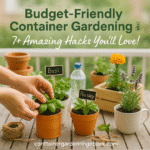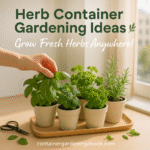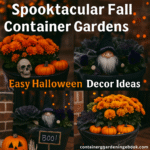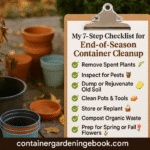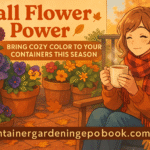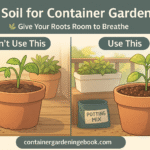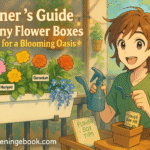Container Gardening
Budget-Friendly Container Gardening: 7+ Amazing Hacks!
Affiliate Disclosure: This post contains affiliate links. If you purchase through these links, I may earn a small commission at no extra cost to you. I only recommend products that will add value to your gardening journey. I appreciate… Continue reading
Herb Container Gardening Ideas: Grow Fresh Herbs Anywhere!
Affiliate Disclosure: This post contains affiliate links. If you purchase through these links, I may earn a small commission at no extra cost to you. I only recommend products that will add value to your gardening journey. I appreciate your… Continue reading
Spooktacular Fall Container Garden Ideas: Easy Halloween Decor Ideas
Affiliate Disclosure: This post contains affiliate links. If you purchase through these links, I may earn a small commission at no extra cost to you. I only recommend products that will add value to your gardening journey. I appreciate your… Continue reading
My 7-Step Checklist for End-of-Season Container Cleanup
Affiliate Disclosure: This post contains affiliate links. If you make a purchase through these links, I may earn a small commission at no extra cost to you. I only recommend products I believe will add value to your gardening… Continue reading
Fall Flowers Power: Brighten Your Landscape with These Late-Season Blooms
Affiliate Disclosure: This post contains affiliate links. If you make a purchase through these links, I may earn a small commission at no extra cost to you. I only recommend products I believe will add value to your gardening journey.… Continue reading
Unlock Thriving Plants: Secrets to the Best Soil for Container Gardening
Affiliate Disclosure: This post contains affiliate links. If you make a purchase through these links, I may earn a small commission at no extra cost to you. I only recommend products I believe will add value to your gardening journey.… Continue reading
Beginner’s Guide to Balcony Flower Boxes: Easy Tips for a Blooming Oasis
Affiliate Disclosure: This post contains affiliate links. If you make a purchase through these links, I may earn a small commission at no extra cost to you. I only recommend products I believe will add value to your gardening journey.… Continue reading
Grow Your Own: Top Container Garden Ideas for Vegetables & Herbs
Affiliate Disclosure: This post contains affiliate links. If you make a purchase through these links, I may earn a small commission at no extra cost to you. I only recommend products I believe will add value to your gardening journey.… Continue reading
African violet potting mix: 1 Ultimate Hack for Drama Queens
Affiliate Disclosure: This post contains affiliate links. If you make a purchase through these links, I may earn a small commission at no extra cost to you. I only recommend products I believe will add value to your gardening journey.… Continue reading
Orchid Potting Mix: 1 Stupid-Simple Way to Not Fail
Affiliate Disclosure: This post contains affiliate links. If you make a purchase through these links, I may earn a small commission at no extra cost to you. I only recommend products I believe will add value to your gardening journey.… Continue reading
